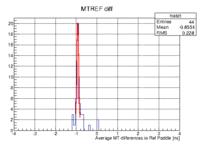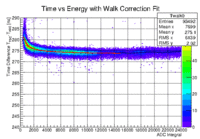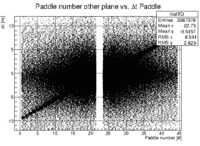Difference between revisions of "First look at TOF calibration"
From GlueXWiki
| Line 5: | Line 5: | ||
*# take care of the 6fold trigger timing shift in the TDC (24ns window) | *# take care of the 6fold trigger timing shift in the TDC (24ns window) | ||
| − | * | + | * Do a rough determination of the walk correction by using the time in the ADC as reference. |
*# calculate Time difference: <math>\Delta t = t^{i}_{TDC}-t^{i}_{ADC}</math> | *# calculate Time difference: <math>\Delta t = t^{i}_{TDC}-t^{i}_{ADC}</math> | ||
*# calculate Integral: I = pulse_integral - pulse_pedestal*nsamples | *# calculate Integral: I = pulse_integral - pulse_pedestal*nsamples | ||
*# [[File:w.gif|200px|tumb||walk correction fit]] Note: the minimum ionizing peak is between 6000 and 10000 | *# [[File:w.gif|200px|tumb||walk correction fit]] Note: the minimum ionizing peak is between 6000 and 10000 | ||
| − | * | + | * Do mean time comparison between different planes |
| − | *# calculate MeanTime of Paddle i in plane j: <math> MT^{i}_{plane j} = (t_{right} | + | *# calculate MeanTime of Paddle i in plane j: <math> MT^{i}_{plane j} = (t_{right} + t_{left})/2. </math> |
| − | *# calculate MeanTime for all Paddles n in plane k: <math> MT^{n}_{plane k} = (t_{right} | + | *# calculate MeanTime for all Paddles n in plane k: <math> MT^{n}_{plane k} = (t_{right} + t_{left})/2. </math> |
| − | *# for each event plot for each paddle in plane k: <math> MT^{n}_{plane k} | + | *# for each event plot for each paddle in plane k: <math> MT^{n}_{plane k} + MT^{i}_{plane j} </math> |
*# [[File:example_mtdiff.gif|200px]] | *# [[File:example_mtdiff.gif|200px]] | ||
*# fit the meant time peak of each projection: | *# fit the meant time peak of each projection: | ||
| Line 22: | Line 22: | ||
*# Calculate the difference between the fit results of each paddle in the first plane w.r.t. THE REFERENCE PADDLE and fit the distribution | *# Calculate the difference between the fit results of each paddle in the first plane w.r.t. THE REFERENCE PADDLE and fit the distribution | ||
*# [[File:Meantime_average_to_refpaddle_example.gif|200px]] average difference of mean time to REFERENCE PADDLE | *# [[File:Meantime_average_to_refpaddle_example.gif|200px]] average difference of mean time to REFERENCE PADDLE | ||
| + | *# Now we have offsets for the Mean-Time for all Paddles w.r.t. THE REFERENCE PADDLE | ||
| + | |||
| + | * Do time difference comparison of one paddle with the paddle number in the other plane | ||
| + | *# calculate time difference: <math> \Delta t^{i}_{plane j} = (t_{right} - t_{left})/2. </math> | ||
| + | *# plot this time difference vs. paddle number of paddles that got hit in the other plane | ||
| + | *# [[File:PaddleNumber_vs_deltat_example.gif|200px]] | ||
Revision as of 15:42, 15 April 2015
First Look
- first select data sample with the following conditions:
- only consider hits within 50ns of the timing peak both for ADC data and TDC data
- only consider paddles that have hits on both ends
- take care of the 6fold trigger timing shift in the TDC (24ns window)
- Do a rough determination of the walk correction by using the time in the ADC as reference.
- Do mean time comparison between different planes
- calculate MeanTime of Paddle i in plane j:

- calculate MeanTime for all Paddles n in plane k:

- for each event plot for each paddle in plane k:

-

- fit the meant time peak of each projection:
-
 example 1
example 1 -
 example 2
example 2 - Do this for each paddle in the first plane as reference paddle.
- Choose one paddle in the first plane as THE REFERENCE PADDLE
- Calculate the difference between the fit results of each paddle in the first plane w.r.t. THE REFERENCE PADDLE and fit the distribution
-
 average difference of mean time to REFERENCE PADDLE
average difference of mean time to REFERENCE PADDLE - Now we have offsets for the Mean-Time for all Paddles w.r.t. THE REFERENCE PADDLE
- calculate MeanTime of Paddle i in plane j:



